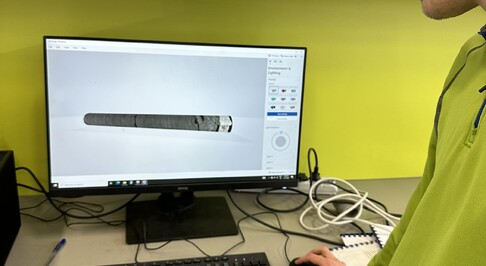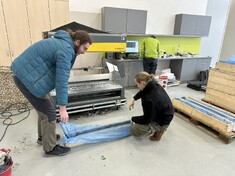[12.4.2024] The PUSH-IT pilot drilling also involves other research work, such as the examination of core samples already drilled. The main purpose of this is to understand the different rock types and their strengths throughout the geological profile of the borehole, and it is also very important to determine the nature and extent of the fractured zones through which naturally occurring groundwater can flow. In order to preserve as much information as possible, the first step in core processing is to scan the core. The scanning produces a digital 3D image of the entire rock column in visible colours. The advantage is that the core is then available for viewing without having to be physically on site and sift through an archive of hundreds of wooden boxes of core samples. By further processing the 3D image of the core, it is possible to identify the nature of the fracture network, the frequency of fractures, their gradient, openness and possibly mineral infill. This information serves as input data for hydrogeological models of groundwater flow. This is because the flow directly influences the distribution of heat in a given location and therefore the efficiency of the planned BTES heat storage facilities.
The core scanning is mainly carried out by a group of students from the Faculty of Science of Charles University under the guidance of the Czech Geological Survey.
Students thus have the opportunity to enter the real world of drilling and rig operation, but they can also compare the actual rock material with the knowledge gained from lectures on sedimentology and structural geology. In the next step, samples are taken from the drill core to measure the thermal properties of the rock and to determine the approximate porosity of each rock layer. The analysis of the thermal properties is carried out directly in the laboratory of the RINGEN research centre and results in a detailed knowledge of the thermal conductivity, thermal diffusivity and volumetric heat capacity. This is because in these rocks the thermal conductivity tends to be lower in the direction perpendicular to the foliation and higher in the direction along the foliation. Knowledge of the thermal properties, in conjunction with knowledge of the groundwater flow rate and direction, will then allow us to model the energy flows in the planned heat storage system and to optimise the design of the drilling fields to maximise the performance and efficiency of the system.
This is a unique opportunity for students to get involved in research in a hands-on way, where they can already experience a research atmosphere during their studies that is not always about reading books and studying theoretical material, which can also motivate them to pursue further academic careers after graduation.


